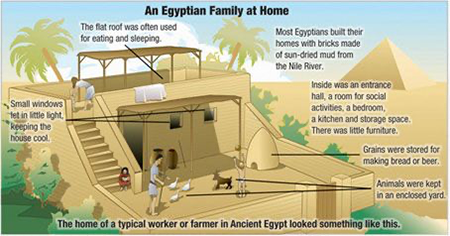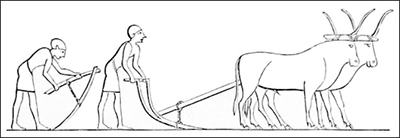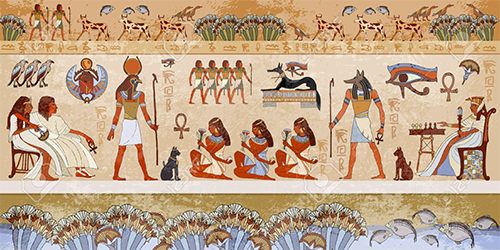Daily life in Ancient Egypt depended very much on how much wealth a family had. The history of the civilization was full of military expeditions and great building projects, but the thing that most people did most often was conduct their day-to-day existence in much the same way from one day to the next.

They lived in homes made of mud bricks, dried by the sun into a material resembling soft stone. Windows were high, to keep out windblown sand, and rare. Inside, in the kitchen, were more mud bricks, in the form of the oven (although some people had clay ovens). The kitchen was mostly open, with matting providing shelter from the elements but allowing oven smoke to escape. Other rooms inside included bedrooms, a living room, and a bathroom. Some homes had interior courtyards that had walls but no roof. Many houses had interior stairs leading to the roof, on which people often spent time; in summer, people slept on the roof because it was cooler than inside the house. Larger homes had multiple bedrooms, storerooms, and specialty rooms such as play rooms for children. Some homes had as many as 30 rooms. People who lived in larger homes enjoyed varying amounts and kinds of furniture, which was rare in smaller homes. For sleeping, the rich had beds with mattresses; people who had less money to spend slept on mats. Tables and chairs (most without arms) were not uncommon. Gardens varied in number and size based on how much money a family had.
People who had money lived in large homes painted white or lined with white limestone, to keep the inside cool. Limestone also made a home sparkle in the sunlight. Some large homes also had colorful interior walls. People walked inside their homes by walking up a small ramp to go inside the front or back door. Both doors were a few feet off the ground, in order to keep out the prevalent sand found in the desert. Not at all uncommon were family homes on the top level of a two-story building, the ground floor of which was a business, such as a bakery or a workshop. Buildings of all kinds were built close together and often shared walls.
The Ancient Egyptians grew many things for food, including grains such as wheat and barley; pulses like beans, chickpeas, and lentils; fruits such as grapes, melons, plums, and pomegranates; and vegetables such as cucumbers, leeks, lettuce, onions, peas, radishes, squashes, and turnips. Another important and tasty crop was figs.

To harvest grain, the Egyptians used axes, hoes, rakes, and sickles. Archaeologists have found some all-metal tools; most tools, though, were all wood or a combination of wood and stone. The Egyptian farmers plowed their fields with plows they powered themselves or ones pulled by oxen. Other animals commonly seen on farms and in villages included cows, ducks, geese, goats, and pigs. Some animals performed tasks, such as goats that trampled the fields in order to push seeds into the ground; others were food sources for people. In addition, some Egyptians kept bees, which produced honey (for sweetening, since sugar didn't exist) and wax.
For food, the ancient Egyptians ate a large amount of bread, made from wheat and barley, vegetables, and fish. Meat was rare and, therefore, expensive, and consumed mainly by the rich. The Egyptians drank mainly beer and (for those who could afford it) wine.
They did trust the Nile to provide water for washing themselves and their clothes (which were, by and large, comfortable items made of linen), and they used as a cleaner the salt-like mineral natron, which embalmers used to keep bodies dry. (Rich people bathed in tubs in their homes.)
The Egyptians believed in a connection between poor hygiene and illness and went out of their way to remain clean. They used soaps and alkaline salts to bathe and shaved their head and body hair. They were makeup of varying amounts in order to protect their faces from the intense rays of the Sun, and they wore deodorant and perfumes in order to smell good. Accentuating their clothing normally was varying amounts of jewelry; gold and silver were the metals of choice for the upper classes, and people with less money wore copper jewelry.

Religion in Ancient Egypt ran through every fabric of life. The people saw the whims of various deities in the variations in the weather, in the rise and fall of kings and empires, and in the smallest decisions of everyday life. A variety of religious festivals punctuated the calendar year. The residents of a town or city commonly adopted one god or goddess as their patron and venerated him or her with one or more temples. All of this focus on religion necessitated a large group of priests and other religious officials, whose job it was to tend to the temples and the ceremonies. Above it all sat the king, the pharaoh, who was the gods' representative on Earth.
Education was also important. The more well-to-do sent their children to local temples in order to be educated. Other parents taught their children at home. Male children learned skills that they would need when they grew up and followed in their father's career footsteps. Professions other than farming (the most prevalent) were baker, carpenter, doctor, teacher, trader, and scribe, the one position that was particularly in demand in the administrations of the king and other leaders. Female children learned from their mothers, how to be a healer and how to care for children and how to manage a household.
The ancient Egyptians enjoyed music, not only singing but also playing bells, chimes, drums, flutes, harps, and other instruments that they made of wood. They also enjoyed active pursuits like archery, boat racing, running, swimming, wrestling, and (in later years) chariot racing and board games, like the vary popular Senet.

Two other major crops grown in Ancient Egypt were flax and papyrus. Flax plants were in high abundance, and the Egyptians used flax fibers to make clothing and other linen items. The Egyptians harvested papyrus reeds and used them to make baskets, boats, mats, paper, rope, and sandals.